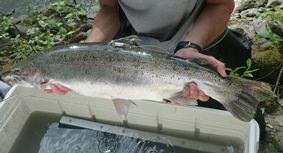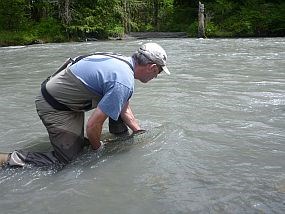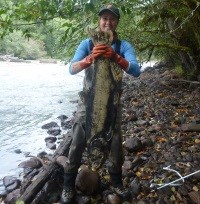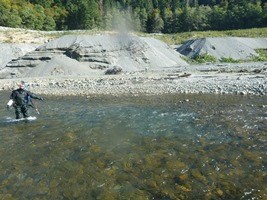|
October 17, 2014
Radio Tagging Continues in the Elwha River
In an effort to understand how fish are recolonizing the Elwha River system, fisheries biologists have been outfitting adult salmon and trout in the lower Elwha River with radio tags. Since April, 97 fish have been captured and tagged. Twenty-seven of these fish - 10 Chinook salmon, 14 bull trout, two steelhead and one sockeye - have been tracked upstream of the Elwha Dam site and six bull trout have been detected above the Glines Canyon Dam site. These fish will be tracked throughout the coming months and provide biologists with valuable information about how fish are recolonizing the undammed Elwha River. Additionally, four Chinook that were not tagged have been observed during snorkel surveys upstream of the Glines Canyon Dam site.

During the upstream migration of salmon, fisheries biologists make weekly visits to the Elwha River to capture and tag adult salmonids. When a fish is captured, it is immediately transferred to a submerged cage made of mesh walls and a PVC frame. The fish is held in the cage for a short time before being outfitted with a radio tag.
A radio tag, smaller than the size of a AAA battery, is attached to the fish at the base of its dorsal fin. Each fish is also photographed, measured, and weighed, two to three scale samples are taken to determine the age of the fish, and a small sample of the anal fin is clipped for genetic analysis. This whole process is completed in less than ten minutes.

Learn more about this project here.
October 2, 2014 This is it –the last dam removal blog post. On August 26, the last 30 feet of Glines Canyon dam were reduced to rubble with one final blast. Last week, the contractor finished removing rubble and debris from the river channel and began packing up. The largest dam removal in history is complete.

Removal of Glines Canyon Dam is a major milestone in the story of Elwha River Restoration, but it is not the end of this story or this blog. As a new month begins and the contractor starts the process of demobilizing from the dam site, Olympic National Park staff are beginning to prepare the area for its public reopening by next summer. Over the winter, infrastructure repairs and improvements, including new parking areas, privies, guardrails, interpretive waysides, and trails, will transform the former dam site into a visitor overlook. The approaching season of wet weather will continue to move sediment downstream and reshape the riparian and nearshore landscapes. Trees, shrubs, and forbes are being planted and seeded in the drained reservoirs and anadromous fish are migrating above Glines Canyon Dam for the first time in over 100 years.

Within a week of the last blast at Glines Canyon Dam, fisheries biologists confirmed that two radio tagged bull trout had migrated through Glines Canyon and were upstream of former Lake Mills in Rica Canyon. Last week, a second snorkel survey confirmed that naturally migrating Chinook had spawned above Glines Canyon Dam for the first time in over 100 years. Dam removal is finished, but this is just the beginning of Elwha River Restoration. |
Last updated: September 9, 2019
